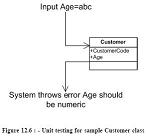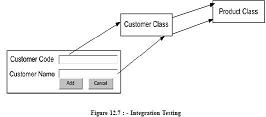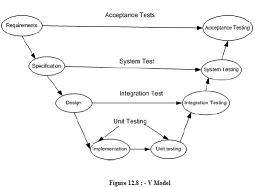What’s the difference between Unit testing, Assembly testing and Regression testing
What’s the difference between Unit testing, Assembly testing and Regression testing?
✍: Guest
Unit testing is also called as Component testing. Unit testing ensures that reliable program
unit meets their requirements. Unit testing is normally conducted by programmer under
the supervision of the project lead or the team Lead. Main objective of this testing is to
test each unit in isolation and individually. This is done by knowing what are the inputs to
the unit and what the expected outputs for the same. Unit testing is a white box activity.
Unit test normally comes in the implementation phase of the project.
For instance in the below figure we are trying to do unit testing on the customer class. So
we create the object of Customer class assign “CustomerCode” and “Age” property and
check for the response. For instance in this condition we tried to pass a non-numeric
value to the “Age” property and the class threw an error saying “Age should be numeric”.
So here the basic unit testing entity is your class.

But unit testing is not limited to a component, object or function. So definition of a unit
testing will depend on the approach. Below are some examples of unit testing:
Check points in UI like tab orders, error messages, look and feel etc.
Class, object, component level testing as said previously.
In case of functional programming can be a simple method or function.
Logic testing for algorithms. Some projects can have some critical algorithm for
instance some kind of custom sorting, security implementation etc. So that logic
can be tested independently.
But the general thumb rule of what is Unit in Unit testing is that the module self contained
and by itself.
Assembly testing goes one step ahead than unit testing. It demonstrates that can the
modules interact in a correct, stable and proper manner as defined by the functional
specifications provided by the client. Assembly testing is Black box testing style and also
called as Integration testing. For instance in the above unit test of the “Customer” class,
testing was done in isolation. But in actually the “Customer” class is not going to be stand
alone rather it will be used more in conjunction with the “Product” class and also will
have UI to do the same. So in short the “Customer” class will work with two more entity
one is the “UI” and the other is the “Product” class. So normally assembly testing is done
through UI but not necessarily.

The above figure defines a simple scenario for integration testing. The same “Customer”
class is now tested with the “UI” and “Product” to see if the interaction between them
matches according to functional specifications.
Regression testing ensures that application function properly even if there are changes or
enhancements to system.For instance you change the “Product” class still you will run all
the test cases for “Product” , “Customer” and “UI” just to make sure that any changes in
“Product” class does not affect interaction with other entities. So you will see when
testers do a regression testing they run all the scripts to ensure that nothing has been
affected.
2007-10-30, 8785👍, 0💬

